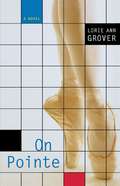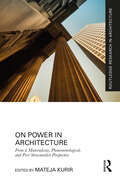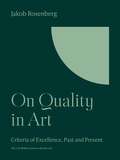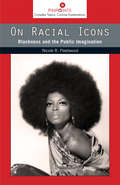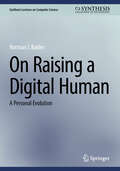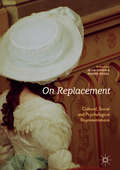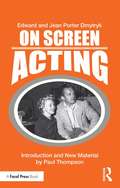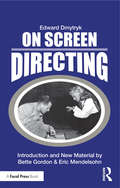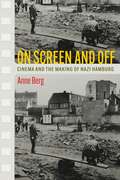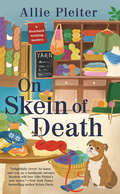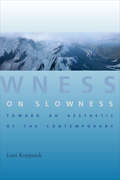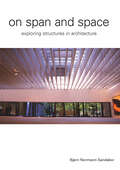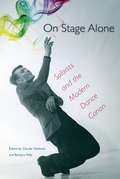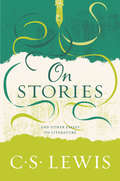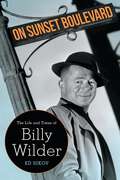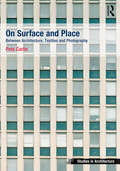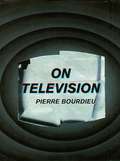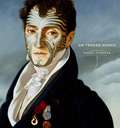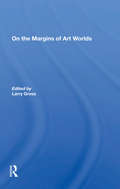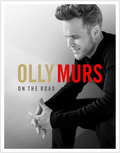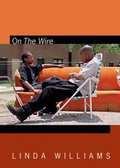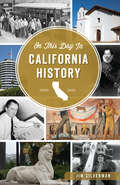- Table View
- List View
On Picture Making and Picture Seeing: A Brief Discourse (Vision, Illusion and Perception #4)
by Jan B. DeręgowskiArchaeological and anthropological investigations of depictions seldom extend beyond a single culture or a single geographical location, although there is a powerful factor common to all depictions, the factor of human perception. In this volume an attempt is made to show how this factor affects both creation and recognition of depictions, how, in common with everyday vision of the environment, typical contours are derived and used, not merely to depict individually readily recognisable models, but also how by concatenation they lead to such a splendid figure as Australian Kakadu crocodiles, or by distortion to creation of illusions of pictorial depth, such as is evoked by Leonardo da Vinci’s perspective and by inverted (Byzantine) perspective thought by some to be an aberration. Bartel’s studies show that pictorial depth is often achieved to the artist’s, and many a viewer’s, but not to geometer’s satisfaction by partial distortion, and Chinese masterpieces embody, side by side, ‘normal’ and inverted perspective. The visual process is universally uniform (if it were not, one would not be able to recognise an Altamira bison as a bison) and its foibles can be freely exploited. Its best known exploiter is probably Cezanne. His pictures are admired by many and puzzle many. Strzemiński postulated that they compound distinct lines of sight, thus endorsing primacy of central vision, a concept thought by Gombrich to be of greater import to geometers than to artists.
On Pointe
by Lorie Ann GroverFor as long as she can remember, Clare and her family have had a dream: Someday Clare will be a dancer in City Ballet Company. For ten long years Clare has been taking ballet lessons, watching what she eats, giving up friends and a social life, and practicing until her feet bleed--all for the sake of that dream. And now, with the audition for City Ballet Company right around the corner, the dream feels so close. But what if the dream doesn't come true? The competition for the sixteen spots in the company is fierce, and many won't make it. Talent, dedication, body shape, size--everything will influence the outcome. Clare's grandfather says she is already a great dancer, but does she really have what it takes to make it into the company? And if not, then what? Told through passionate and affecting poems in Clare's own voice, On Pointe soars with emotion as it explores what it means to reach for a dream--and the way that dreams can change as quickly and suddenly as do our lives.and affecting poems in Clare's own voice, On Pointe soars with emotion as it explores what it means to reach for a dream -- and the way that dreams can change as quickly and suddenly as do our lives.
On Power in Architecture: From a Materialistic, Phenomenological, and Post-Structuralist Perspective (Routledge Research in Architecture)
by Mateja KurirArchitecture has always been a decisive manifestation of power. This volume represents an attempt to question and reflect on the relationship between power and architecture from three philosophical perspectives: materialistic, phenomenological and post-structuralist.This collection opens an interdisciplinary investigation that aims to reflect on architecture and its interconnectedness with power within philosophy and cultural theory at large while presenting these concepts using practical examples from the built environment. Internationally recognised authors – philosophers, architectural theorists and historians – Andrew Benjamin, Andrew Ballantyne, Mladen Dolar, Hilde Heynen, Nadir Lahiji, Jeff Malpas, Dean Komel, Elke Krasny, Robert Pfaller, Gerard Reinmuth, Luka Skansi, Douglas Spencer, Teresa Stoppani and Sven-Olov Wallenstein present their reflections in original unpublished essays and interviews. In the presented works, architecture is combined and transgressed by philosophy in a new discussion that focuses only on power. The contributions in this collection open a variety of architectural questions, one of the central among them being the impact of neoliberal capitalism on architecture. Architecture, with its implications on the complex contemporary political and social reality, is severely changing our space and, more globally, our environment. A reflection on the multilayered relation between architecture and power has never been as topical as it is today.This book will, therefore, be of interest to students, researchers and academics or professionals within the fields of architecture, philosophy, sociology, political sciences and cultural sciences.
On Quality in Art: Criteria of Excellence, Past and Present (The A. W. Mellon Lectures in the Fine Arts #13)
by Jakob RosenbergAn acclaimed art historian explains how to identify excellence in artIn this book, Jakob Rosenberg takes up the timeless problem of how to make a valid judgment about artistic quality. In his search for criteria of excellence in art, Rosenberg examines both the achievements and failures of other critics from the Renaissance to modern times, including Giorgio Vasari, Roger de Piles, Sir Joshua Reynolds, Théophile Thoré, and Roger Fry. Drawing vital lessons from these critics’ writings, Rosenberg charts an effective approach to the challenges of judging quality in works of art by analyzing master drawings from the fifteenth to twentieth centuries and comparing them with examples of followers or minor contemporaries. The result is a set of practical criteria that are applicable across diverse periods and styles. Brimming with insights from a legendary art critic and historian, On Quality in Art sheds invaluable light on drawings by artists ranging from Dürer, Raphael, Leonardo, Rubens, Rembrandt, Watteau, Degas, and van Gogh to Matisse, Picasso, and Marin.
On Racial Icons
by Nicole R. FleetwoodWhat meaning does the American public attach to images of key black political, social, and cultural figures? Considering photography's role as a means of documenting historical progress, what is the representational currency of these images? How do racial icons "signify"? Nicole R. Fleetwood's answers to these questions will change the way you think about the next photograph that you see depicting a racial event, black celebrity, or public figure. In On Racial Icons, Fleetwood focuses a sustained look on photography in documenting black public life, exploring the ways in which iconic images function as celebrations of national and racial progress at times or as a gauge of collective racial wounds in moments of crisis. Offering an overview of photography's ability to capture shifting race relations, Fleetwood spotlights in each chapter a different set of iconic images in key sectors of public life. She considers flash points of racialized violence in photographs of Trayvon Martin and Emmett Till; the political, aesthetic, and cultural shifts marked by the rise of pop stars such as Diana Ross; and the power and precarity of such black sports icons as Serena Williams and LeBron James; and she does not miss Barack Obama and his family along the way. On Racial Icons is an eye-opener in every sense of the phrase.
On Raising a Digital Human: A Personal Evolution (Synthesis Lectures on Computer Science)
by Norman I. BadlerThis book tells the story of building digital virtual human models in the context of the background, choices, and occurrences that shaped the author's own involvement and personal evolution. Such digital models found motivating applications in engineering, anthropology, medical, and group simulation problems, and numerous connections to other disciplines informed and enriched their design, development, and deployment. This personal perspective on developments in the field is enhanced by extensive citations that provide pointers into relevant literature, recognize the contributions of co-authors and collaborators, and give external evidence for claims. Both academic and corporate interest in virtual beings has exploded in recent years, and while this book does not survey the current state of the art it is an essential window into how the field arrived where it is today. The technical discussions throughout the book are deliberately accessible with extensive references to the literature for further reading. This book will be of interest to readers who want to understand the history of virtual human beings, how they evolved, and especially how they must address numerous human characteristics to achieve any sense of "human-ness."
On Replacement: Cultural, Social and Psychological Representations
by Jean Owen Naomi SegalThis book is an interdisciplinary study of the human drama of replacement. Is one’s irreplaceability dependent on surrounding oneself by a replication of others? Is love intrinsically repetitious or built on a fantasy of uniqueness? The sense that a person’s value is blotted out if someone takes their place can be seen in the serial monogamy of our age and in the lives of ‘replacement children’ – children born into a family that has recently lost a child, whom they may even be named after. The book investigates various forms of replacement, including AI and doubling, incest and bedtricks, imposters and revenants, human rights and ‘surrogacy’, and intertextuality and adaptation. The authors highlight the emotions of betrayal, jealousy and desire both within and across generations. On Replacement consists of 24 essays divided into seven sections: What is replacement?, Law & society, Wayward women, Lost children, Replacement films, The Holocaust and Psychoanalysis. The book will appeal to anyone engaged in reading cultural and social representations of replacement.
On Screen Acting: An Introduction to the Art of Acting for the Screen (Edward Dmytryk: On Filmmaking)
by Edward Dmytryk Jean Porter DmytrykWith On Screen Acting, director Edward Dmytryk and actress Jean Porter Dmytryk offer a lively dialogue between director and actress about the principles and practice of screen acting for film and television. Informal and anecdotal in style, the book spans auditioning, casting, rehearsal, and on-set techniques, and will be of interest to both aspiring and working actors and directors. <p><p>Originally published in 1984, this reissue of Dmytryk’s classic acting book includes a new critical introduction by Paul Thompson, as well as chapter lessons, discussion questions, and exercises.
On Screen Directing (Edward Dmytryk: On Filmmaking)
by Edward DmytrykWith On Screen Directing, renowned filmmaker Edward Dmytryk distills a lifetime of experience as a director into a dozen short essays on the craft of directing, spanning every stage of the filmmaking process, from screenwriting, preproduction, and casting to set design, postproduction, and promotion. <p><p>Originally published in 1984, this reissue of Dmytryk’s classic directing book includes a new critical introduction by Bette Gordon and Eric Mendelsohn, as well as chapter lessons, discussion questions, and exercises.
On Screen Writing (Edward Dmytryk: On Filmmaking)
by Edward DmytrykWith On Screen Writing, director Edward Dmytryk offers a clear, methodical overview of the needs, practices, and problems of screenwriting, including extensive coverage of adaptation. Written In an informal, anecdotal style and using script examples from Hollywood classics, Dmytryk presents a practical set of principles for writing engaging, filmable screenplays. <p><p>Originally published in 1985, this reissue of Dmytryk’s classic screenwriting book includes a new critical introduction by Mick Hurbis-Cherrier, as well as chapter lessons, discussion questions, exercises, and a glossary.
On Screen and Off: Cinema and the Making of Nazi Hamburg
by Anne BergOn Screen and Off shows that the making of Nazism was a local affair and the Nazi city a product of more than models and plans emanating from Berlin. In Hamburg, film was key in turning this self-styled "Gateway to the World" into a "Nazi city." The Nazi regime imagined film as a powerful tool to shape National Socialist subjects. In Hamburg, those very subjects chanced upon film culture as a seemingly apolitical opportunity to articulate their own ideas about how Nazism ought to work. Tracing discourses around film production and film consumption in the city, On Screen and Off illustrates how Nazi ideology was envisaged, imagined, experienced, and occasionally even fought over.Local authorities in Hamburg, from the governor Karl Kaufmann to youth wardens and members of the Hamburg Film Club, used debates over cinema to define the reach and practice of National Socialism in the city. Film thus engendered a political space in which local activists, welfare workers, cultural experts, and administrators asserted their views about the current state of affairs, articulated criticism and praise, performed their commitment to the regime, and policed the boundaries of the Volksgemeinschaft. Of all the championed "people's products," film alone extended the promise of economic prosperity and cultural preeminence into the war years and beyond the city's destruction. From the ascension of the Nazi regime through the smoldering rubble, going to the movies grounded normalcy in the midst of rupture.
On Skein of Death (A Riverbank Knitting Mystery #1)
by Allie PleiterFor Libby Beckett, opening her charming yarn shop, and introducing customers to the joys of knitting and crochet, is the work she was meant to do. Until the yarn she loves is used for murder…. Libby has come home to Collinstown, Maryland to live her dream and open her own yarn shop, aptly named Y.A.R.N., along the Chester River. To Libby, Y.A.R.N. stands for "You're Absolutely Ready Now." But the acronym changes whenever inspiration strikes, and customers add to the list of suggestions that fill the blackboard wall in a shop stuffed with color, fiber, and comfort. Libby is thrilled when she lands famous Norwegian knitting celebrity Perle Langager for a series of events at Y.A.R.N. Libby's English bulldog, Hank, has been modeling one of Perle's doggie sweaters, and customers just can't wait to see Perle in action. The mayor of Collinstown even decrees a Collinstown Yarn Day to celebrate. But once Perle arrives in town, she seems distracted and on edge. And when she's found strangled with a skein of red yarn, Libby knows she has to solve a knotty mystery before her new life unravels.
On Slowness
by Lutz KoepnickA counterintuitive take on the deceleration of time and its function in contemporary art and culture.
On Slowness: Toward an Aesthetic of the Contemporary (Columbia Themes in Philosophy, Social Criticism, and the Arts)
by Lutz KoepnickSpeed is an obvious facet of contemporary society, whereas slowness has often been dismissed as conservative and antimodern. Challenging a long tradition of thought, Lutz Koepnick instead proposes we understand slowness as a strategy of the contemporary—a decidedly modern practice that gazes firmly at and into the present's velocity.As he engages with late twentieth- and early twenty-first-century art, photography, video, film, and literature, Koepnick explores slowness as a critical medium to intensify our temporal and spatial experiences. Slowness helps us register the multiple layers of time, history, and motion that constitute our present. It offers a timely (and untimely) mode of aesthetic perception and representation that emphasizes the openness of the future and undermines any conception of the present as a mere replay of the past. Discussing the photography and art of Janet Cardiff, Olafur Eliasson, Hiroshi Sugimoto, and Michael Wesely; the films of Peter Weir and Tom Tykwer; the video installations of Douglas Gordon, Willie Doherty, and Bill Viola; and the fiction of Don DeLillo, Koepnick shows how slowness can carve out spaces within processes of acceleration that allow us to reflect on alternate temporalities and durations.
On Span and Space: Exploring Structures in Architecture
by Bjorn N. SandakerIn this richly illustrated book with many practical examples, Bjorn Sandaker provides readers with a better understanding of the relationship between technology and architecture. As an experienced teacher and writer, Sandaker offers a well-founded aesthetic theory to support the understanding and evaluation of a structure's form and design, examining concepts and viewpoints from both the professions of engineering and architecture. Comprehensively covering structure and aesthetics, this book is ideal for students, professionals and academics in the areas of architecture and building.
On Stage Alone: Soloists and the Modern Dance Canon
by Claudia Gitelman Barbara PalfySoloists ignited the modern dance movement and have been a source of its constant renewal. Pioneering dancers such as Loïe Fuller, Isadora Duncan, Ruth St. Denis, and Maud Allan embodied the abstraction and individuality of the larger modernist movement while making astounding contributions to their art. Nevertheless, solo dancers have received far less attention in the literature than have performers and choreographers associated with large companies.In On Stage Alone, editors Claudia Gitelman and Barbara Palfy take an international approach to the solo dance performance. The essays in this standout volume broaden the dance canon by bringing to light modern dance soloists from Europe, Asia, and the Americas who have shaped significant, sustained careers by performing full programs of their own choreography.Featuring in-depth examinations of the work of artists such as Michio Ito, Daniel Nagrin, Ann Carlson, and many others, On Stage Alone reveals the many contributions made by daring solo dancers from the dawn of the twentieth century through today. In doing so, it explores many important statements these soloists made regarding topics such as freedom, personal space, individuality, and gender in the modern era.
On Stories: And Other Essays on Literature
by C. S. LewisA repackaged edition of the revered author’s collection of essays on writing fiction.C. S. Lewis—the great British writer, scholar, lay theologian, broadcaster, Christian apologist, and bestselling author of Mere Christianity, The Screwtape Letters, The Great Divorce, The Chronicles of Narnia, and many other beloved classics—was a professor of literature at Oxford University, where he was known for his insightful and often witty presentations on the nature of stories. This collection assembles nine essays that encapsulate his ideas about fiction, including "On Stories," "The Death of Words," and "On Three Ways of Writing for Children," as well as eleven pieces that were unpublished during his lifetime.
On Sunset Boulevard: The Life and Times of Billy Wilder
by Ed SikovOn Sunset Boulevard, originally published in 1998, describes the life of acclaimed filmmaker Billy Wilder (1906-2002), director of such classics as Sunset Boulevard, The Lost Weekend, The Seven Year Itch, and Sabrina. This definitive biography takes the reader on a fast-paced journey from Billy Wilder's birth outside of Krakow in 1906 to Vienna, where he grew up, to Berlin, where he moved as a young man while establishing himself as a journalist and screenwriter, and triumphantly to Hollywood, where he became as successful a director as there ever was.Double Indemnity, Sunset Boulevard, Some Like It Hot, and The Apartment"Wilder's cinematic legacy is unparalleled. Not only did he direct these classics and twenty-one other films, he co-wrote all of his own screenplays. Volatile, cynical, hilarious, and driven, Wilder arrived in Hollywood an all-but-penniless refugee who spoke no English. Ten years later he was calling his own shots, and he stayed on top of the game for the next three decades. Wilder battled with Humphrey Bogart, Marilyn Monroe, Bing Crosby, and Peter Sellers; kept close friendships with William Holden, Audrey Hepburn, Jack Lemmon, and Walter Matthau; amassed a personal fortune by way of blockbuster films and shrewd investments in art (including Picassos, Klees, and Mir's); and won Oscars--yet Wilder, ever conscious of his thick accent, always felt the sting of being an outsider.On Sunset Boulevard traces the course of a turbulent but fabulous life, both behind the scenes and on the scene, from Viennese cafes and Berlin dance halls in the twenties to the Hollywood soundstages of the forties and the on-location shoots of the fifties and sixties. Crammed with Wilder's own caustic wit, On Sunset Boulevard reels out the story of one of cinema's most brilliant and prolific talents.
On Surface and Place: Between Architecture, Textiles and Photography (Ashgate Studies in Architecture)
by Peta CarlinOn Surface and Place is a rich and poetic exploration of surfaces which foregrounds their significance in our understanding and experience of place. Adopting weaving as its overarching metaphor, it departs from Gottfried Semper’s discussion of correspondences between architecture and textiles, and emerges from the reading of photographs, a swatch of Harris Tweed and curtain wall façade juxtaposed. In juxtaposing the fabric of the city with the weave of Harris Tweed the book charts an original course across a range of connected ideas and questions, combining many different themes, writers and disciplines. It presents integrated and innovative rethinkings on a number of fundamental relationships, including correlations between body and building, word and image, and between the rural and the metropolitan, and the hand-crafted and the mass-reproduced. In doing so, it seeks to foreground the very interrelationship of surface and place, as it makes a claim for the relational nature of the world in which we live.
On Television
by Pierre BourdieuBourdieu had long been concerned with the role of television in cultural and political life when he bypassed the political and commercial control of the television networks and addressed his country's viewers from the television station of the College de France. "On Television," which expands on that lecture, not only describes the limiting and distorting effect of television on journalism and the world of ideas, but offers the blueprint for a counterattack.
On Tender Hooks
by Lucy Blue Justin Giarla Shag Colin Berry Isabel Samaras The PizzIsabel Samaras's quirky, sexy, pop-surrealist art has had a cult following for years and now at long last her first monograph, On Tender Hooks, is here. Drawing her influence from classic TV shows and paintings by the Old Masters--for example riffing on Gricault's Raft of the Medusa by replacing the figures with characters from Gilligan's Island--Samaras has created a witty, erotic, and surreal body of work. This fresh and dazzling volume includes a three-way interview between Samaras and fellow low-brow artists Shag and The Pizz, as well as delightful and enlightening commentary from gallerist Justin Giarla and art writer Colin Berry, and an erotic short story by Lucy Blue.
On The Margins Of Art Worlds
by Larry GrossDuring the late 1980s, the near-worship of artistic genius produced auction sales of works by Vmcent Van Gogh and Pablo Picasso for tens of millions of dollars, over $15 million for a painting by Jasper Johns, and record prices for works by many other deceased and even living masters. At the same time, it was no longer controversial in academic and intellectual circles to maintain that art works are the products of what Howard Becker has termed collective activity carried out within loosely defined art worlds: Works of art, from this point of view, are not the products of individual makers, "artists" who possess a rare and special gift. They are, rather, joint products of all the people who cooperate via an art world's characteristic conventions to bring works like that into existence. Artists are some sub-group of the world's participants who, by common agreement, possess a specialgift, therefore make a unique and indispensable contribution to the work, and thereby make it art. (1982: 35) The concept of the art world-with its central focus on the collective, social, and conventional nature of artistic production, distribution, and appreciation--confronts and potentially undermines the romantic ideology of art and artists still dominant in Western societies.
On The Road: The real stories on tour
by Olly MursWant to know what really goes on during an Olly Murs UK tour? Then get the lowdown in my new book, On The Road - the official, uncensored, up close and personal story of 2015's Never Been Better UK adventure. Packed with 200 exclusive pictures, this fly-on-the-wall release captures all the excitement and drama of a 27-gig trip around the country, including the jokes, arguments, heartbreaks and giggles, with some parties thrown in along the way. You could say it's an exclusive insight into all the hard work that goes into putting on a nationwide tour for the best fans in the world. That's not all, though. Keep your eyes peeled for several special guest appearances from the likes of Robbie Williams, Jonathan Ross and the comedians, Russell Brand and John Bishop. One or two Premier League footballers rock up in the story, and I fall victim to a few terrible practical jokes. If that's not enough, there's also the untold story of what really happened when I got the X Factor job.Planes, tourbuses and a helicopter ride or two: On The Road is the access-all-areas tale of my biggest ever headline tour. I promise it's going to give my fans a real insight into what my life's like really behind the scenes - grumps, giggles and all. Don't believe me? Just watch...
On The Wire
by Linda WilliamsMany television critics, legions of fans, even the president of the United States, have cited The Wire as the best television series ever. In this sophisticated examination of the HBO serial drama that aired from 2002 until 2008, Linda Williams, a leading film scholar and authority on the interplay between film, melodrama, and issues of race, suggests what exactly it is that makes The Wire so good. She argues that while the series is a powerful exploration of urban dysfunction and institutional failure, its narrative power derives from its genre. The Wire is popular melodrama, not Greek tragedy, as critics and the series creator David Simon have claimed. Entertaining, addictive, funny, and despairing all at once, it is a serial melodrama grounded in observation of Baltimore's people and institutions: of cops and criminals, schools and blue-collar labor, local government and local journalism. The Wire transforms close observation into an unparalleled melodrama by juxtaposing the good and evil of individuals with the good and evil of institutions.
On This Day in California History (On This Day In)
by Jim SilvermanCalifornia has a rich history of cultural innovation and colorful characters. On May 26, 1853, Lola Montez premiered her famous Spider Dance routine in San Francisco. On February 21, 1937, San Diego’s Waldo Waterman created one of the first operational flying cars. Emeryville’s Wham-O sold the first Frisbee, earlier called a Flyin’ Cake Pan, on January 13, 1957. Entrepreneurs Steve Jobs, Steve Wozniak and Ronald Wayne established Apple Inc. on April 1, 1976. With a historical account for each day of the year, Jim Silverman highlights the unforgettable stories that have defined California.

